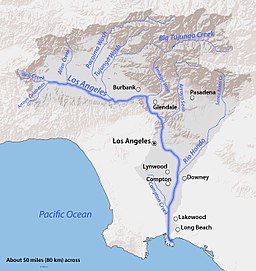Los Angeles river
| Los Angeles River | |
|
Near Downtown Los Angeles
|
|
| Country | United States |
|---|---|
| State | California |
| Tributaries | |
| - left | Bell Creek, Browns Canyon Wash, Aliso Creek, Tujunga Wash, Verdugo Wash, Arroyo Seco, Rio Hondo |
| - right | Arroyo Calabasas, Compton Creek |
| Cities | Burbank, Glendale, Los Angeles, Downey, Compton, Long Beach |
| Source | Confluence of Bell Creek and Arroyo Calabasas |
| - location | Canoga Park, San Fernando Valley |
| - elevation | 794 ft (242 m) |
| - coordinates | 34°11′43″N 118°36′08″W / 34.19528°N 118.60222°W |
| Mouth | Pacific Ocean |
| - location | Los Angeles Harbor, Long Beach |
| - elevation | 0 ft (0 m) |
| - coordinates | 33°45′23″N 118°11′20″W / 33.75639°N 118.18889°WCoordinates: 33°45′23″N 118°11′20″W / 33.75639°N 118.18889°W |
| Length | 47.9 mi (77 km) |
| Basin | 827 sq mi (2,142 km2) |
| Discharge | for Long Beach |
| - average | 226 cu ft/s (6.40 m3/s) |
| - max | 129,000 cu ft/s (3,652.87 m3/s) |
| - min | 2 cu ft/s (0.06 m3/s) |
|
Map of the Los Angeles River watershed
|
|
The Los Angeles River (L.A. River) starts in the Simi Hills and Santa Susana Mountains and flows through Los Angeles County, California, from Canoga Park in the western end of the San Fernando Valley, nearly 48 miles (77 km) southeast to its mouth in Long Beach. Several tributaries join the once free-flowing and frequently flooding river, forming alluvial flood plains along its banks. It now flows through a concrete channel on a fixed course, which was built after a series of devastating floods in the early 20th century.
Environmental groups and park advocates support the removal of concrete and the restoration of natural vegetation and wildlife. Portions of the river now have earthen bottoms and restored habitat. There are also plans for a series of parks along the river's city frontage in Los Angeles. The Los Angeles River also flows through several Los Angeles County communities and has been featured in many Hollywood films.
Before the opening of the Los Angeles Aqueduct, the river was the primary source of fresh water for the city. Although the Los Angeles region still gets some of its water from the river and other local sources, most comes from several aqueducts serving the area. The river suffers pollution from agricultural and urban runoff.
...
Wikipedia


